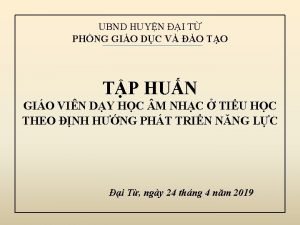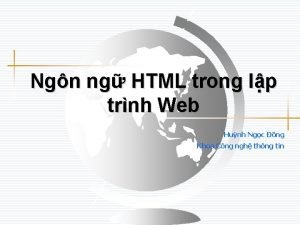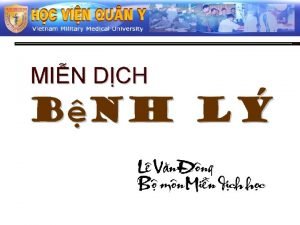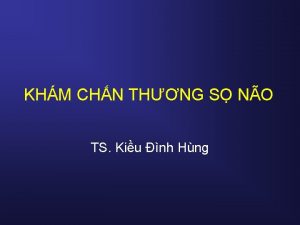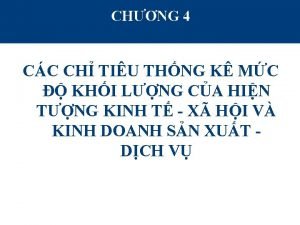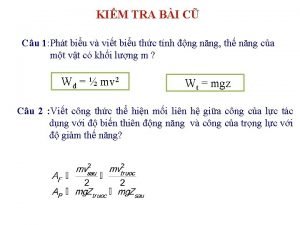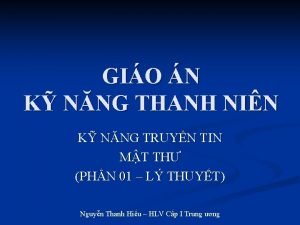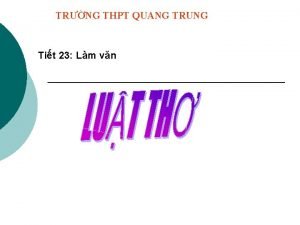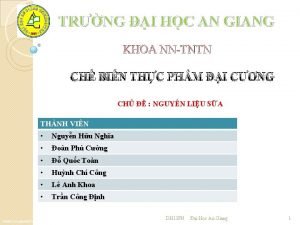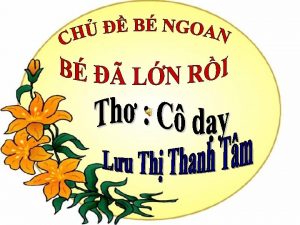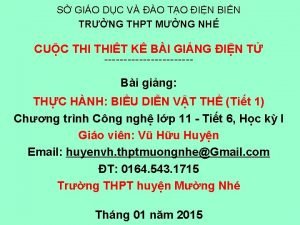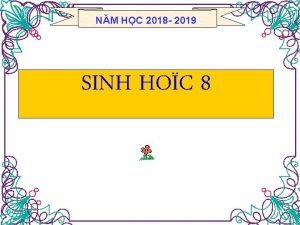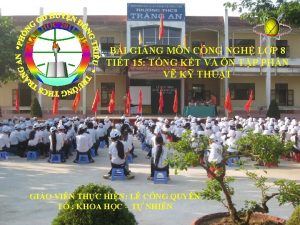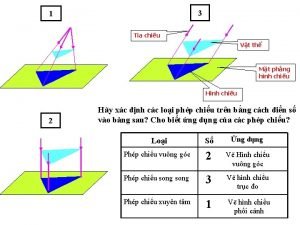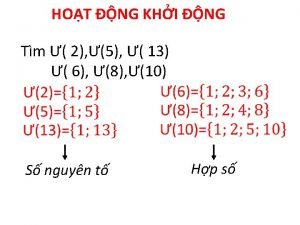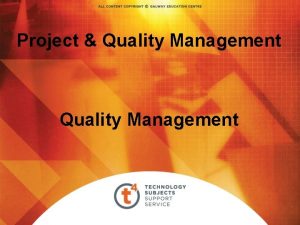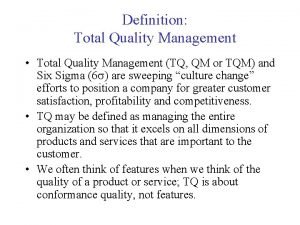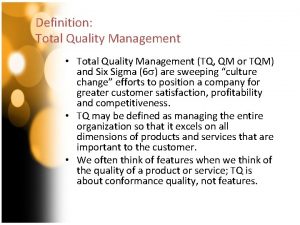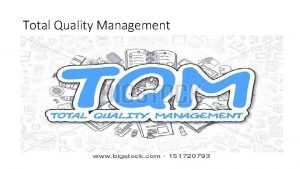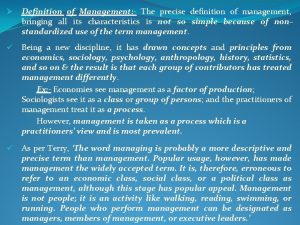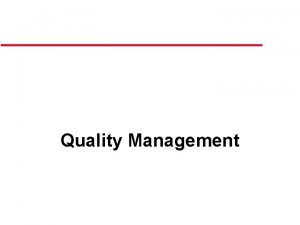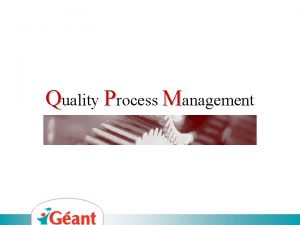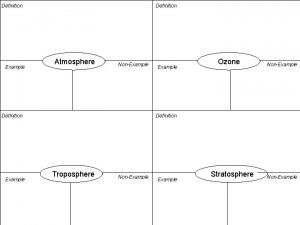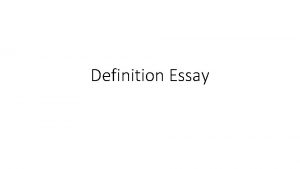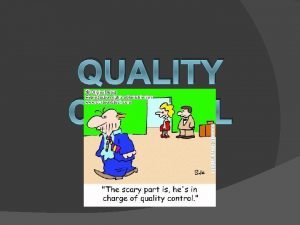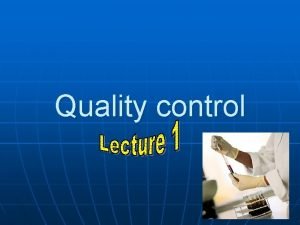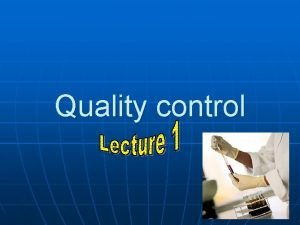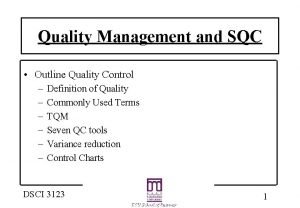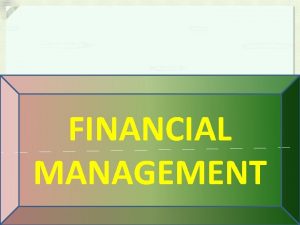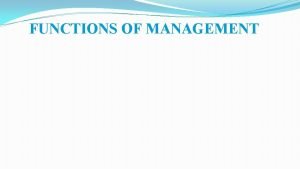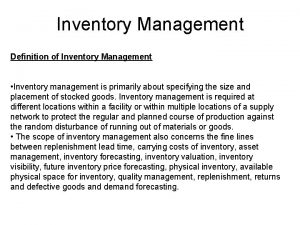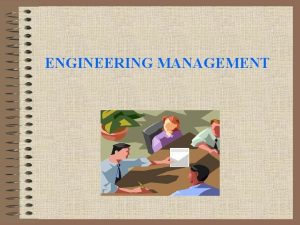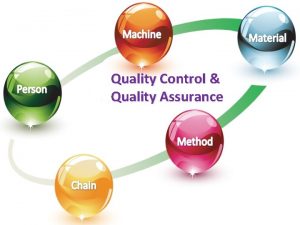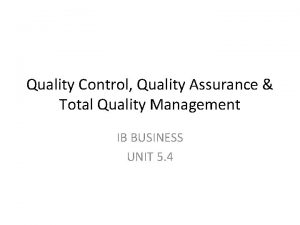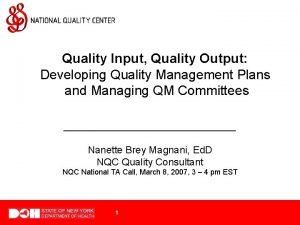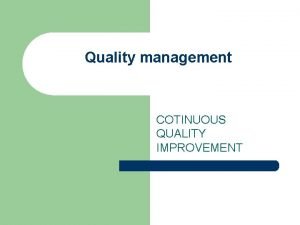Quality Management Definition of Quality Quality is the





































- Slides: 37

Quality Management

Definition of Quality: • Quality is the totality of features and characteristics of a product or service that bear on its ability to satisfy stated or implied needs. • Some goals of quality programs include: – Fitness for use. (Is the product or service capable of being used? ) – Fitness for purpose. (Does the product or service meet its intended purpose? ) – Customer satisfaction. (Does the product or service meet the customer's expectations? ) – Conformance to the requirements. (Does the product or service conform to the requirements? )

Quality Management Processes • Quality Planning • Quality Assurance • Quality Control

Quality Planning • The process of identifying which quality standards are relevant to the project and determining how to satisfy them. • Input includes: Quality policy, scope statement, product description, standards and regulations, and other process Output. • Methods used: benefit / cost analysis, benchmarking, flowcharting, and design of experiments • Output includes: Quality Management Plan, operational definitions, checklists, and Input to other processes.

Quality Assurance • The process of evaluating overall project performance on a regular basis to provide confidence that the project will satisfy the relevant quality standards. • Input includes: Quality Management Plan, results of quality control measurements, and operational definitions. • Methods used: quality planning tools and techniques and quality audits. • Output includes: quality improvement.

Quality Control • The process of monitoring specific project results to determine if they comply with relevant quality standards and identifying ways to eliminate causes of unsatisfactory performance. • Input includes: work results, Quality Management Plan, operational definitions, and checklists. • Methods used include: inspection, control charts, pareto diagrams, statistical sampling, flowcharting, and trend analysis. • Output includes: quality improvements, acceptance decisions, rework, completed checklists, and process adjustments

Major Approaches to Quality and QM • • • Deming Juran Crosby TQM Six Sigma ISO 9000

W Edwards Demming on Quality • Quality is an attribute of a product or service that can only be defined by the customer. • Because of this its meaning is relative • Quality or lack of it is one of the outcomes of the specific business process that produces a product or service • Quality is produced by proper execution of such a process • The job of quality management is to provide the system and the leadership to facilitate such proper execution

Joseph M. Juran: On Quality • Quality is “fitness for use” • Balance between product features and products free from deficiencies • Features must meet customer expectations • Absence of deficiency is as essential as desired features in producing customer satisfaction • So the ultimate test of quality is fitness for use by customers as reflected by customer satisfaction

Juran: The Trilogy of Quality Management • Quality Planning – developing a process to achieve goals involving customer satisfaction • Quality Control – holding onto gains, controlling variation, preventing waste • Quality Improvement – lowering cost of poor quality achieving innovation in performance

Philip B. Crosby: Quality • Conformance to requirements • Must be defined in measurable terms and expressed as a clear target • Either present or not present • The Cost of Quality (COQ) = Price of Conformance (POC) + Price of Non. Conformance (NPOC) • POC is cost of getting things done right the first time • NPOC is the cost of waste

Crosby: Four Absolutes of Quality • Conformance to the requirements: This idea of quality must be integrated into the enterprise • The system of quality is prevention (eliminating errors before they occur) • The performance standard is zero defects • The measure of quality is the PONC: the lower the PONC the more widespread the quality • These four absolutes must be attained through strong discipline, complete leadership commitment, substantial resource allocation for training, tools, and appropriate personnel, and Crosby’s 14 -step approach to achieving conformance.

Total Quality Management: Quality • “we define quality as consistently producing what the customer wants while reducing errors before and after delivery to the customer. More importantly, however, quality is not so much an outcome as a never ending process of continually improving the quality of what your company produces. ” David Chaudron qualitymanagement. com • Close derivative of Deming’s approach to Quality

Total Quality Management • “A structured system for satisfying employees, customers, and suppliers by integrating the business environment, continuous improvement, and breakthroughs with development, improvement, and maintenance cycles while changing organizational culture” (from iqd. com). • Great emphasis on needs and requirements analysis • Uses a systems approach with strong emphasis onboth cultural and technological elements • Strong emphasis on prevention and role of • leadership • Closely related to Deming’s approach to QM

Six Sigma: Quality • The value added by a productive endeavour • Potential quality is the maximum possible value added per unit of input. • Actual quality is the current value added per unit of input • The difference between the two is waste Six Sigma is focused on reducing waste, cycle time, defects, and those costs that do not add value • Goal is virtually error-free performance

Six Sigma: Key Elements • Implements “proven” quality principles and a select few of the myriad QM techniques • Performance is measured by the sigma level measure of variability in the company’s business processes • Uses a Define-Measure-Analyze-Improve-Control (DMAIC) model • Define goals • Measure existing system and processes • Analyze (including stat analysis) & develop plan closing gap • Improve system (Use stat methods to validate) • Control the new system by institutionalizing it through new policies and rules

Six Sigma: Implementation approach • Senior leadership training in principles & tools for organization success, followed by SLs directing development of management infrastructure & innovation-friendly culture supporting Six Sigma. • Develop systems establishing close communication with customers, employees, & suppliers. Includes rigorous methods and ways of overcoming cultural, policy, and procedural barriers • Rigorously assess training needs, provide remedial basic skills education, and comprehensive training in systems improvement tools, techniques, and philosophies • Develop framework for continuous process improvement along with system of indicators for monitoring progress and success. • Projects for improving business performance linked to measurable financial results. • Six Sigma projects conducted by individual employees & teams led by change agents (Master Black, and Green Belts)

ISO 8402 and 9000: Quality and QM • “The totality of characteristics of an entity that bear on its ability to satisfy stated and implied needs” ISO 8402 • Quality management: activities performed to formulate and implement policies and programs intended to achieve quality. • Examples: – – quality planning, quality control, quality assurance, and quality improvement

ISO 9000: Eight Principles • Customer Focus (on needs and requirements) • Leadership (establish unity of purpose, direction, environment for participation) • Involvement of people (full) • Process Approach (managing activities & resources) • Systems Approach to Management (of inter-related processes) • Continual Improvement (of processes and performance) • Factual Approach to Decision Making (analysis of data/info) • Mutually Beneficial supplier relationships

Commonalities in QM Approaches • QM approaches tend to view quality in terms of value produced by business processes for customers • Reshape and control process to get quality • Tend to take a systems, but not a complex adaptive systems approach • Emphasize scientific approaches, empirical investigation, statistical analysis, formal knowledge processing • Emphasize metrics and measurement • View QM as an integrated set of activities designed to have a direct impact on all business processes and their inter-relations

Commonalities in QM Approaches • Use Technological and particularly IT tools and techniques • Employ a wide range of analytical techniques and also social interaction and human intervention techniques • Emphasizes strongly the elimination of errors before they happen: prevention • Strong emphasis on cause-and-effect analysis suggesting a deterministic view of quality • Strong emphasis on leadership and its role in QM • Widespread emphasis on organizational learning framework to produce knowledge needed for achieving quality, e. g. PDSA.

Quality Concepts • Zero Defects – Implies that there is no tolerance for errors within the system. – The goal of all processes is to avoid defects in the product or service. – Similar to six sigma: almost zero defects • The Customer is the Next Person in the Process – The internal organization has a system that ensures the product or service is transferred to the next person in the process in a complete and correct manner. – The product or service being built is transferred to another internal party only after it meets all the specifications and all actions at the current work station. – Avoids incorrectly assembled components and poor workmanship.

Quality Concepts • Do the Right Thing Right the First Time (DTRTRTFT) – Implies that it is easier and less costly to do the work right the first time than it is to do it the second time. – Entails the training of personnel to ensure sufficient skills and tools to correctly complete the work. • Continuous Improvement Process (CIP) (From Japanese word, Kaizen) – A sustained, gradual change to improve the situation. – Differs from innovation -- does not make a sudden jump to a plateau where it matures over time. – Focuses on 11 principles: constancy of purpose, commitment to quality, customer focus and involvement, process orientation, continuous improvement, system-centered management, investment in knowledge, teamwork, conservation of human resources, total involvement, and perpetual commitment.

Project Characteristics/Attributes that bear on quality • Producibility (technology required) • Ability of a product or service to be produced within the existing technology, human resources, skills, knowledge, and materials at a cost compatible with market expectations. • Producibility is one of the most critical aspects of developing any new product. • Usability (effort expended to use) • The ability of a product to perform its intended function for the specified user under the prescribed conditions. • Usability is determined by examining performance, function and condition of a product.

Project Characteristics/Attributes that bear on quality • Reliability (MTBF) • The degree to which a unit of equipment performs its intended function under specified conditions for a specified period of time. • Computed by 2 methods of Mean-Time-Between-Failure (MTBF): – Predicted MTBF: Based on a mathematical computation of a component failure using a tree diagram to determine sequential failure aspects of the component rated periods. Least desirable method because it cannot account for environmental variations that can degrade components to lower rates. – Actual MTBF: Use of field collected data to compute the failures under realistic operating conditions to find the average time between failure. The actual reliability will seldom be the same as the predicted reliability

Project Characteristics/Attributes that bear on quality • Maintainability (Mean-Time-To-Repair: MTTR) • The ability of a unit to be restored within a specified time to its performance capability under the environmental operating conditions within a specified, average period of time. • Availability (Probability of performance) • The probability of a product being capable of performing a required function under the specified conditions when called upon. • The key parts of availability are reliability and maintainability. • Operability (Expected conditional use) • The ability of a product to be operated by human resources for specified periods of time under given conditions without significant degradation of the output. • Flexibility (Expected variable use) • The ability of a product to be used for different purposes at different capacities and under different conditions.

Project Characteristics/Attributes that bear on quality • Social Acceptability (Environment and safety) – The degree of compatibility between the characteristics of a product or service and the prevailing values and expectations of the relevant society – The degree to which a public accepts a product for use. • Affordability (Return for quality required) – The ability to develop, acquire, operate, maintain, and dispose of a product over its life.

Cost of Quality • Cost of quality is the total price of all efforts to achieve product or service quality. This includes all work to build a product or service that conforms to the requirements as well as all work resulting from nonconformance to the requirements. • The typical project should have a goal of between 3 -5% of the total value as the cost of a quality program depending on the type of project and its total dollar value. – Cost to build right the first time – Training programs – Statistical Process Control (SPC) Costs • Cost of a quality system is often viewed as a negative cost because errors in work have been traditionally accepted as a cost of doing business. •

Cost of Conformance • • • Planning Training and indoctrination Process control Field testing Product design validation Process validation Test and evaluation Quality audits Maintenance and calibration

Cost of Nonconformance • • • Scrap Rework Expediting Additional material or inventory Warranty repairs or service Complaint handling Liability judgments Product recalls Product corrective actions

Cost of Non-Quality • Cost of non-quality is estimated to be 1220% of sales. • Waste of time and materials • Rework of poor quality products • Additional material • Delays in schedule • Product and service image • Corporate image

Major Cost Categories of Quality • Prevention Cost - cost to plan and execute a project so that it will be error-free • Appraisal Cost - cost of evaluating the processes and the Output of the processes to ensure the product is error-free • Internal Failure Cost - cost incurred to correct an identified defect before the customer receives the product • External Failure Cost - cost incurred due to errors detected by the customer. This includes warranty cost, field service personnel training cost, complaint handling, and future business losses. • Measurement and Test Equipment - capital cost of equipment used to perform prevention and appraisal activities.

Opportunities for Reducing Cost • Just-in-Time - concept of zero inventory in a manufacturing plant. Reduces cost of storing and moving parts; cost of inventory; cost of parts damaged through handling, etc. • Product Life Cycle Cost - concept of reducing overall product life cycle cost by linking the cost areas of the product life cycle (R&D, acquisition, and operations and maintenance) and considering each one's cost implications for the other. • Product Maturity - Identifying, documenting, and correcting failures early helps products achieve stability earlier in the life cycle.

Opportunities for Reducing Cost • Areas of Waste in Projects – – – – Waste in rejects of completed work Waste in design flaws Waste in work-in-process Waste in motion for manpower (under-trained employee) Waste in management (Improper direction of work) Waste in manpower (Misplaced or waiting workers) Waste in facilities (Ordering excess material) Waste in expenses (Unnecessary meetings, travel)

Quality and People in Project Management • Management defines type and amount of work • Management is 85% responsible for quality • The employee can only assume responsibility for meeting the requirements of completing the work when the employee: • Knows what's expected to meet the specifications • Knows how to perform the functions to meet the specifications • Has adequate tools to perform the function • Is able to measure the performance during the process • Is able to adjust the process to match the desired outcome

Quality and People in Project Management • Project quality team consists of: – Senior Management – Project Manager – Project Staff – Customer – Vendors, suppliers, and contractors – Regulatory Agencies

Quality and People in Project Management • Reviews & Audits – Management reviews determine the status, progress made, problems, and solutions – Peer reviews determine whether proposed or completed work meets the requirements – Competency center reviews are used to validate documentation, studies, and proposed technical solutions to problems. – Fitness reviews and audits determine the fitness of a product or part of a project. (addresses specific issues) • The collection of quantitative data for statistical analysis is the basis for proactive Management by FACT rather than by EXCEPTION. Management by exception lets errors and defects happen before Management intervention.
 Hình ảnh bộ gõ cơ thể búng tay
Hình ảnh bộ gõ cơ thể búng tay Frameset trong html5
Frameset trong html5 Bổ thể
Bổ thể Tỉ lệ cơ thể trẻ em
Tỉ lệ cơ thể trẻ em Voi kéo gỗ như thế nào
Voi kéo gỗ như thế nào Tư thế worm breton là gì
Tư thế worm breton là gì Chúa yêu trần thế alleluia
Chúa yêu trần thế alleluia Các môn thể thao bắt đầu bằng từ đua
Các môn thể thao bắt đầu bằng từ đua Thế nào là hệ số cao nhất
Thế nào là hệ số cao nhất Các châu lục và đại dương trên thế giới
Các châu lục và đại dương trên thế giới Cong thức tính động năng
Cong thức tính động năng Trời xanh đây là của chúng ta thể thơ
Trời xanh đây là của chúng ta thể thơ Mật thư anh em như thể tay chân
Mật thư anh em như thể tay chân Phép trừ bù
Phép trừ bù Phản ứng thế ankan
Phản ứng thế ankan Các châu lục và đại dương trên thế giới
Các châu lục và đại dương trên thế giới Thể thơ truyền thống
Thể thơ truyền thống Quá trình desamine hóa có thể tạo ra
Quá trình desamine hóa có thể tạo ra Một số thể thơ truyền thống
Một số thể thơ truyền thống Cái miệng nó xinh thế
Cái miệng nó xinh thế Vẽ hình chiếu vuông góc của vật thể sau
Vẽ hình chiếu vuông góc của vật thể sau Biện pháp chống mỏi cơ
Biện pháp chống mỏi cơ đặc điểm cơ thể của người tối cổ
đặc điểm cơ thể của người tối cổ Ví dụ giọng cùng tên
Ví dụ giọng cùng tên Vẽ hình chiếu đứng bằng cạnh của vật thể
Vẽ hình chiếu đứng bằng cạnh của vật thể Vẽ hình chiếu vuông góc của vật thể sau
Vẽ hình chiếu vuông góc của vật thể sau Thẻ vin
Thẻ vin đại từ thay thế
đại từ thay thế điện thế nghỉ
điện thế nghỉ Tư thế ngồi viết
Tư thế ngồi viết Diễn thế sinh thái là
Diễn thế sinh thái là Dạng đột biến một nhiễm là
Dạng đột biến một nhiễm là Bảng số nguyên tố
Bảng số nguyên tố Tư thế ngồi viết
Tư thế ngồi viết Lời thề hippocrates
Lời thề hippocrates Thiếu nhi thế giới liên hoan
Thiếu nhi thế giới liên hoan ưu thế lai là gì
ưu thế lai là gì Khi nào hổ con có thể sống độc lập
Khi nào hổ con có thể sống độc lập
